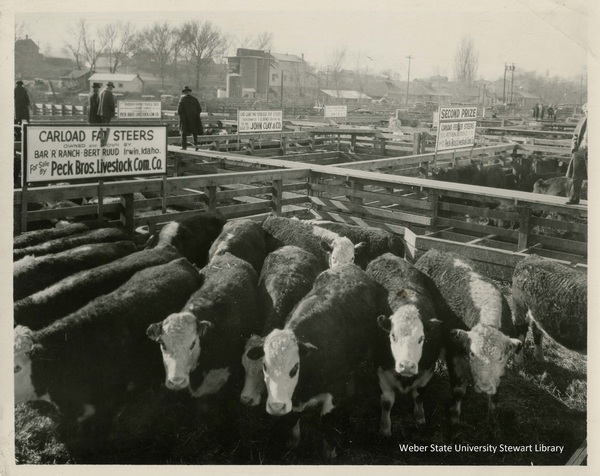Dublin Core
Title
Description
Today, most shoppers depend on large grocery chains to buy cuts of meat. But, until the late nineteenth century, food was a more local affair. Most Utahns were close to their food sources, often growing their own gardens or visiting local farms. It wasn’t uncommon to butcher your own meat or frequent a local butcher shop. But the relationship between food and community changed drastically in the early twentieth century as more Utahns moved away from farms into urban centers. Food became big business, and the Ogden Union Stockyards played a key role in this cultural shift in the Intermountain West.
Beginning in the 1910s as a few stock pens near the Ogden rail yard in Weber County, the Ogden Union Stockyards rapidly grew to be the largest stockyard operation west of Denver. Feeding city dwellers required several moving parts. The stockyards offered a streamlined operation designed to meet the changing needs of farmers and their businesses. Livestock could be purchased, slaughtered, packed up, and shipped out on railcars all from the stockyards. It was truly a model of efficiency that helped move meat from rural Utah to more populous areas.
As more people moved to cities, it became harder to feed a growing population who no longer raised their own livestock. Local farmers and butchers did not have the capacity to process large numbers of animals and shipping meat was challenging. The Ogden Stockyard was a valuable stopover where animals could be rested and fattened up before arriving at their final destination: the slaughterhouse. Rail lines, refrigerated railcars, and the industrialization of meatpacking eased many of the barriers that previously prevented getting meat onto store shelves.
The Ogden Union Stockyards not only helped move livestock and meat across the region. It also disconnected urban Utahns from the source of their food. Meat purchased from the shelves of grocery stores moved butchering outside of public view, separating consumers from their food source and the community that raised it. Although the Ogden Stockyards closed in the early 1970s, the relationship between those who raise food and those who consume it remains largely disconnected.
Creator
Source
_______________
See Sheri Murray Ellis, “The Last Word in Stockyard Construction: The Rise and Fall of the Ogden Union Stockyard,” Utah Historical Quarterly 85, no. 1, 2017; Jalynn Olsen, The Union Stockyards, Building by the Railyard - The Historic Commercial and Industrial Architecture of Ogden, Utah, Western Regional Architecture Program (University of Utah), 1998; Adam Schofield, “Ogden Union Stockyards,” Intermountain Stories, n.d.; Miriam B. Murphy, “The Rise and Fall of Ogden’s Meatpacking Industry,” History Blazer, June 1996; Rachel Badali, “Public Can Relive Ogden Stockyard History,” Weber State University, December 21, 2015; “Historic American Landscapes Survey: Ogden Union Stockyards,” National Register of Historic Places, 2014.

